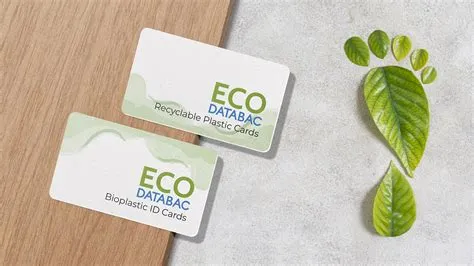Hey there, business owners and brand managers! Ever thought about your company ID cards as more than just a security pass? They’re mini-billboards, silent ambassadors for your brand, representing your company’s values and image to everyone who sees them. And in today’s world, that image is increasingly shaped by sustainability. So, let’s dive into the exciting world of innovative ID card design trends, focusing on how eco-friendly choices can significantly elevate your corporate image.
Think of your ID cards like a handshake – the first impression is crucial. A well-designed, eco-friendly ID card speaks volumes about your company’s commitment to the planet and its forward-thinking approach. It’s a subtle yet powerful way to communicate your values and resonate with environmentally conscious customers and employees.
Beyond the Basics: Moving Past Plastic
For years, plastic dominated the ID card landscape. But times are changing. We’re seeing a dramatic shift towards sustainable materials, and it’s not just a trend; it’s a reflection of a growing global awareness. Are you ready to join the revolution?
Let’s face it, mountains of plastic ID cards piling up in landfills aren’t exactly a great look for any business. Choosing eco-friendly alternatives, like recycled materials or plant-based options, projects a positive image that resonates deeply with today’s consumers. Think about it: would you rather hand your employees a card that screams “environmental responsibility” or one that whispers “another plastic piece contributing to waste”?
The Green Advantage: Why Eco-Friendly ID Cards Matter
The benefits extend beyond just environmental consciousness. By choosing sustainable ID cards, your company demonstrates:
Corporate Social Responsibility (CSR): This is a HUGE deal. Customers are increasingly drawn to businesses that prioritize ethical and environmental practices. Showcasing your commitment through eco-friendly ID cards strengthens your brand reputation and builds trust.
Employee Engagement: Employees are more likely to be proud of and invested in a company that shares their values. Offering eco-friendly ID cards shows that you care about their wellbeing and the planet, fostering a stronger sense of belonging and loyalty.
Cost Savings (Long-term): While initial costs might seem slightly higher, long-term savings can be achieved through reduced waste disposal fees and enhanced brand reputation, leading to increased customer loyalty and reduced marketing costs.
Marketing Advantage: Use your eco-friendly ID cards as a marketing tool! Highlight your commitment to sustainability on the cards themselves. It’s a subtle but effective way to spread your message.
Design Innovation: Sustainability Meets Style
Eco-friendly doesn’t have to mean boring! The design possibilities are endless. We’re seeing stunning innovations in:
Materials: Explore recycled PVC, biodegradable materials like bamboo, or even seed paper cards that can be planted after use! Learn more about eco-friendly ID card materials available today.
Printing Techniques: Soy-based inks and water-based coatings are becoming increasingly popular, minimizing the environmental impact of the printing process. Check out our blog on eco-friendly printing techniques for more details.
Design Aesthetics: Integrate natural elements, earthy tones, and minimalist designs into your ID card aesthetics. This seamlessly blends sustainability with a sophisticated look.
Beyond the Material: Smart Card Integration
Let’s not forget the technological advancements that enhance both functionality and sustainability. Smart card technology offers a number of advantages:
Durability: Smart cards are more resistant to damage than traditional cards, extending their lifespan and reducing waste.
Digital Integration: By incorporating digital features, you minimize the need for paper-based processes, reducing your paper consumption and carbon footprint. Discover more about technology-integrated ID cards and their possibilities.
Security: Smart cards offer enhanced security features, protecting sensitive information and preventing fraud.
Industry-Specific Approaches
The ideal eco-friendly ID card design isn’t one-size-fits-all. Consider your industry and the specific needs of your company:
Healthcare: Focus on hygiene and durability, choosing easily sanitizable materials.
Hospitality: Prioritize a visually appealing design that reflects the brand’s aesthetic.
Manufacturing: Choose durable, water-resistant materials appropriate for industrial environments. For more on this, read about industry-specific ID card designs. You can also find industry-specific design trends and customization examples at design trends in industry-specific ID cards and customization and personalization in ID card design.
Corporate offices: Prioritize brand consistency and professional aesthetics.
Personalization: The Human Touch
Remember that personalization can greatly enhance the impact of your ID cards. Adding a personal touch, such as employees’ names or even a small, unique design element, shows that you value your workforce and reinforces a sense of community. This is crucial for employee retention and engagement. Read more on customization and design for ideas.
Making the Switch: A Step-by-Step Guide
Ready to upgrade your ID cards? Here’s a simple plan:
1. Assess Your Current Situation: Analyze your current ID card design and identify areas for improvement.
2. Research Sustainable Materials: Explore the options available and choose materials that align with your brand and environmental goals.
3. Collaborate with a Designer: Work with a professional designer to create a visually appealing and functional eco-friendly ID card. Explore more modern designs at modern ID card design ideas.
4. Choose a Responsible Printer: Select a printer that uses sustainable printing methods.
5. Implement and Monitor: Track your progress and assess the impact of your eco-friendly ID cards on your brand image and environmental footprint.
Conclusion:
In a world increasingly focused on sustainability, your company ID cards are more than just identification; they are powerful communication tools. By choosing eco-friendly materials and innovative designs, you not only reduce your environmental impact but also significantly enhance your corporate image, demonstrating your commitment to a greener future and building a stronger, more responsible brand. It’s a win-win! Don’t underestimate the power of a small change to make a big impact. Learn more about maximizing the impact of eco-friendly solutions by reading about eco-friendly business solutions and their impact. And remember, sustainable practices are not just a trend—they are the future.
FAQs:
1. How much more expensive are eco-friendly ID cards than traditional plastic cards? The cost difference can vary depending on the materials and printing methods chosen. While some eco-friendly options may have a slightly higher upfront cost, the long-term benefits in terms of brand image and environmental responsibility often outweigh this.
2. What are the most common eco-friendly materials used for ID cards? Recycled PVC, bamboo, and seed paper are among the most popular sustainable materials used in ID card production.
3. Can eco-friendly ID cards be just as durable as traditional plastic cards? Absolutely! Many eco-friendly materials offer comparable or even superior durability, depending on the chosen material and lamination process.
4. Do eco-friendly printing techniques compromise the quality of the ID card design? Not at all! Modern eco-friendly printing methods deliver vibrant, high-quality results that are comparable to traditional printing techniques.
5. How can I measure the impact of switching to eco-friendly ID cards? You can track your reduced plastic waste, increased positive brand perception through customer and employee feedback, and cost savings from reduced disposal fees and enhanced brand reputation.

